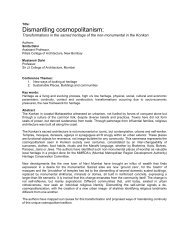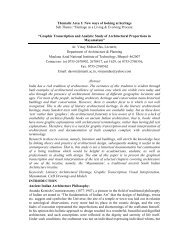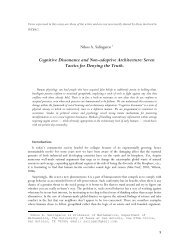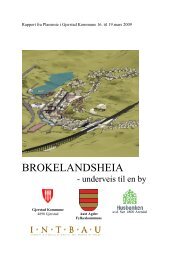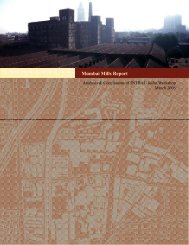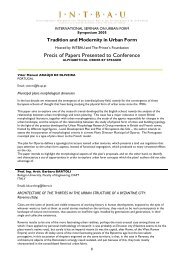Amit Bhatt, Prerna Mehta, Sarika Panda - Intbau
Amit Bhatt, Prerna Mehta, Sarika Panda - Intbau
Amit Bhatt, Prerna Mehta, Sarika Panda - Intbau
Create successful ePaper yourself
Turn your PDF publications into a flip-book with our unique Google optimized e-Paper software.
Table 18: Comparative Evaluation of Proposed and Built Commercial Spaces in DistrictCentres (in 1000 sqm)Sl. No. Zones Proposed Built %age of total1 North 987 97 9.832 East 762 146 19.163 Central 334 327 97.904 West 2132 368 17.265 South 1022 600 58.716 Urban Extension 4375 0 0.00Source: Times of India, 10 November 2006Hope, opportunity and livelihood drove people by the lakhs to the city which, in turn, createdan unprecedented demand for new shop and office space. And as the authorities failed toreact to the city’s growth, market forces moved in and created commercial spaces inresidential areas. The total legitimate commercial space available in the city’s district centresby 2001 was a little over 15 million sq metres, including space in those started under the1961-81 master plan. This was against the DDA’s own projected requirement of over 96million sq metres by 2001. Thus, over a period of 40 years (1961-2001), the DDA madeavailable only about l6% of what was needed by its own estimates and promised by theMPDs. Given that the district centres were supposed to account for close to three-fourths ofall commercial space in the city, community centres and local shopping complexesaccounting for the rest, this enormous shortfall has meant the city is seriously starved ofcommercial space and has adopted its own means for fulfilling it.5. ISSUESThe foregoing clearly highlights that there is a rampant transformation occurring in the cityboth in terms of landuse as well as usage of premises. The socio-economic factors areprimarily responsible for this transformation. The increasing population needs basic serviceof housing resulting in unauthorized extension, alteration and construction of residentialstructures. The pressure of market forces coupled with lack supply of legitimate commercialspaces is resulting in transformation of housing stock into commercial properties. Some ofthe other key issues involved in Delhi are summarized below:• At present, Delhi with its population of 13.78 million is the third largest, fastest growingand most densely populated city in India that is growing by approximately 1,000 personsper day for a number of years• This increase in population, backed with inadequate release of land and funds for shelterand infrastructure is causing rapid landuse transformation and emergence of sub standardsettlements• The inadequate development and implementation of Master Plan leaves this task into thehands of market forces causing haphazard development of commercial spaces andtransformation of housing stock into commercial properties• Delhi is also the most prosperous amongst the states and union territories of India. Thehigh quality of life offered by Delhi, compared to its neighboring states acts as a pullfactor for neighboring population who not only come to Delhi for employment but alsofor an improved quality of life• The failure to develop and implement National Capital Region Plan is another issueresponsible for increasing the plight of Delhi15



